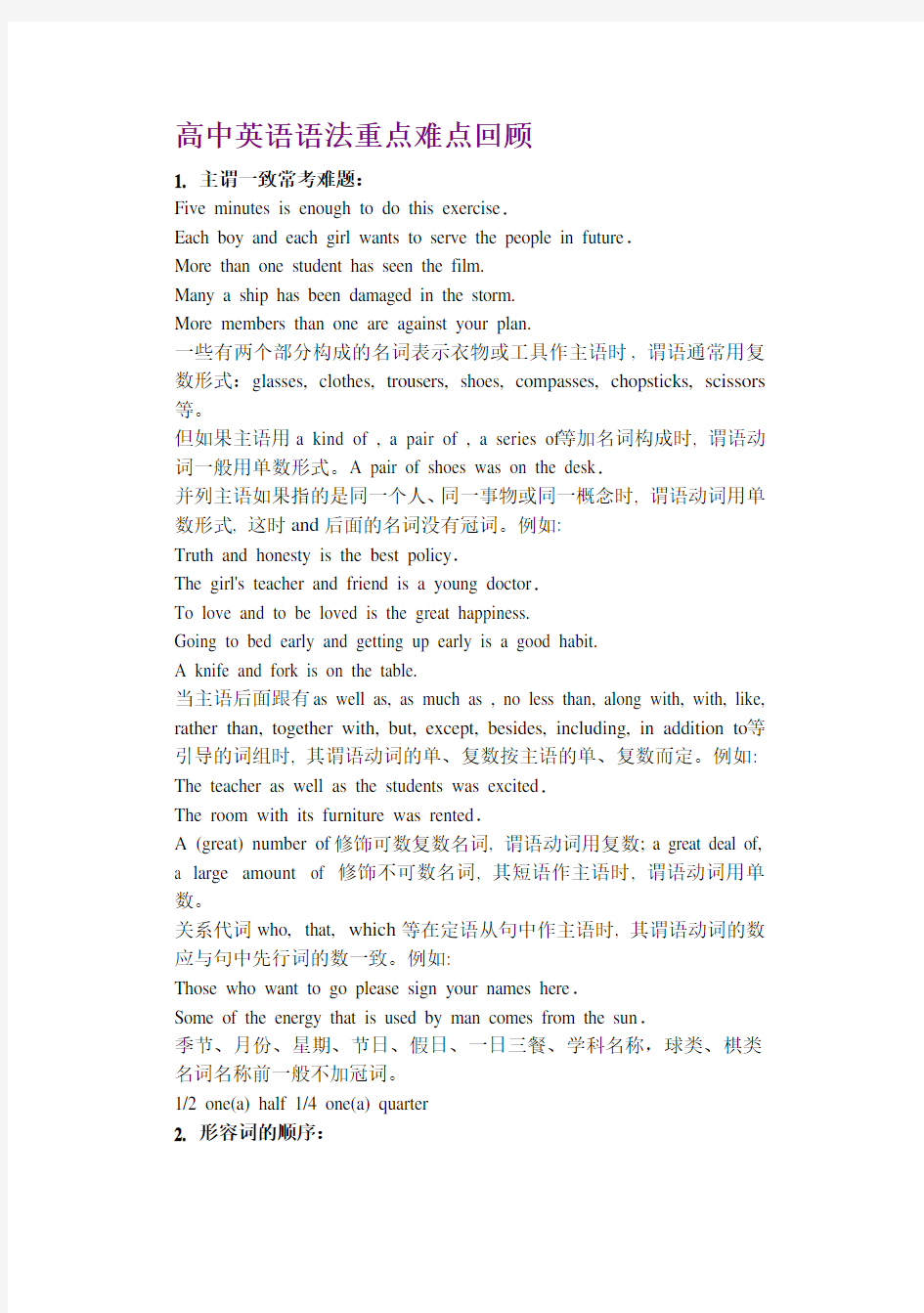
高中英语重点难点知识点复习.
- 格式:doc
- 大小:45.50 KB
- 文档页数:9


高中英语语法重点难点回顾
1. 主谓一致常考难题:
Five minutes is enough to do this exercise.
Each boy and each girl wants to serve the people in future.
More than one student has seen the film.
Many a ship has been damaged in the storm.
More members than one are against your plan.
一些有两个部分构成的名词表示衣物或工具作主语时, 谓语通常用复数形式:glasses, clothes, trousers, shoes, compasses, chopsticks, scissors 等。
但如果主语用a kind of , a pair of , a series of等加名词构成时, 谓语动词一般用单数形式。A pair of shoes was on the desk.
并列主语如果指的是同一个人、同一事物或同一概念时, 谓语动词用单数形式, 这时and后面的名词没有冠词。例如:
Truth and honesty is the best policy.
The girl's teacher and friend is a young doctor.
To love and to be loved is the great happiness.
Going to bed early and getting up early is a good habit.
A knife and fork is on the table.
当主语后面跟有as well as, as much as , no less than, along with, with, like, rather than, together with, but, except, besides, including, in addition to等引导的词组时, 其谓语动词的单、复数按主语的单、复数而定。例如: The teacher as well as the students was excited.
The room with its furniture was rented.
A (great) number of修饰可数复数名词, 谓语动词用复数; a great deal of, a large amount of 修饰不可数名词, 其短语作主语时, 谓语动词用单数。
关系代词who, that, which等在定语从句中作主语时, 其谓语动词的数应与句中先行词的数一致。例如:
Those who want to go please sign your names here.
Some of the energy that is used by man comes from the sun.
季节、月份、星期、节日、假日、一日三餐、学科名称,球类、棋类名词名称前一般不加冠词。
1/2 one(a) half 1/4 one(a) quarter
2. 形容词的顺序:
系动词be,grow,get,become,feel,appear,prove,seem,look,keep,smell,taste,sound,turn,remain限定词+数量形容词(序数词在前,基数词在后)+性状形容词+大小、长短、高低等形体+新旧+颜色+国藉+材料
Those three beautiful large square old brown wood table
某些以a-开首的形容词例如:afraid,alike,alone,asleep,awake, alive 等只能作表语,不能作定语。
某些以-ly结尾的词是形容词而不是副词:friendly,lively,lovely,lonely,likely,deadly,silly,orderly, timely等。
1)close接近地closely仔细地,密切地
2)free 免费地freely自由地,无拘束地
3)hard努力地hardly几乎不
4)late 晚,迟lately 近来
5)most 极,非常mostly主要地
6)wide广阔地,充分地widely广泛地
7)high高highly高度地,非常地
8)deep深,迟deeply抽象意义的“深”
9)loud大声地loudly大声地(含有喧闹的意思)
10)near邻近nearly几乎
3. 比较级,最高级
表示一方不及另一方时,用“less+原级+than”的结构表示:This room is less beautiful than that one.
表示一方超过另一方的程度或数量时,可在比较级前加表示程度的状语,如:even,a lot,a bit,a little,still,much,far, yet, by far等修饰:He works even harder than before.
注意:by far 通常用于强调最高级。用于比较级时,一般放在比较级的后面, 如放在前面,应在二者中间加“the”。
He is taller by far than his brother.
He is by far the taller of the two brothers.
某些以-or结尾的形容词进行比较时,用to代替than。superior,junior,senior等。
He is superior to Mr. Wang in mathematics.
在比较从句中为了避免重复通常用that(those),one(ones)代替前面出现的名词。that指物,one既可指人,也可指物。that可代替可数名词单数和不可数名词,而one只能代替可数名词。例如:
The book on the table is more interesting than that on the desk.